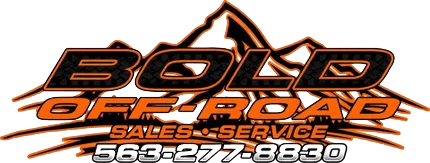OEM vs Aftermarket Parts: Which Saves You Money Long-Term?
OEM vs. Aftermarket Parts: What’s the Best Value Over Time?
By Dave Barrette, Owner of Bold Off-Road
You need a new CV axle for your Polaris Ranger. Your mechanic gives you two options: OEM or aftermarket. The aftermarket part costs less upfront. But will it last? Which choice actually saves you money long-term?
At Bold Off-Road in Coggon, Iowa, we install both OEM and aftermarket parts depending on the situation. Over 25 years, we've learned which parts are worth the extra investment and which aftermarket options perform just as well. This guide helps you make the right choice.
Understanding OEM Parts
OEM stands for Original Equipment Manufacturer. These parts come from the company that built your UTV, ATV, or Jeep. When you buy a Polaris OEM part, Polaris made it to their exact specifications.
OEM parts offer guaranteed fitment. They match the original component perfectly. Installation is straightforward with no modifications needed.
Warranty coverage on OEM parts typically extends for one year. If the part fails due to manufacturing defects, you're covered.
"We use OEM parts for anything that affects safety or major systems," says Dave Barrette, owner of Bold Off-Road. "Brake components, steering parts, suspension pieces. The cost difference disappears quickly if an aftermarket part fails and damages other components."
Understanding Aftermarket Parts
Aftermarket parts come from third-party manufacturers. Companies like SuperATV and High Lifter produce parts designed to fit your machine. Quality ranges from excellent to terrible depending on the manufacturer.
The best aftermarket parts equal or exceed OEM quality. Some companies engineer improvements over the original design. SuperATV's heavy-duty axles use stronger materials than stock Polaris axles.
Budget aftermarket parts sacrifice quality for lower cost. Thinner metal, softer materials, and looser tolerances mean these parts wear faster and fail sooner.
The challenge is identifying quality. Hundreds of manufacturers exist. Without experience, you can't tell the difference until after installation.
When OEM Parts Make Sense
Safety systems demand OEM quality. Brake calipers, master cylinders, brake lines, pads, steering components, tie rods, and ball joints should always be OEM.
Major engine and transmission components benefit from OEM parts. Pistons, valves, gears, and bearings operate under extreme stress where manufacturing tolerances matter.
New machines under warranty require OEM parts for covered repairs. Using aftermarket parts can void your warranty.
Complex electrical systems work best with OEM parts. ECUs, wiring harnesses, and sensors need precise compatibility.
When Aftermarket Parts Make Sense
Wear items like belts, filters, and brake pads have excellent aftermarket options. Quality aftermarket versions perform identically to OEM parts.
Performance upgrades always come from the aftermarket. Lift kits, bigger tires, upgraded suspension, and enhanced lighting aren't available from manufacturers.
Body panels and cosmetic parts work fine as aftermarket. Fenders, hoods, and bumpers don't affect mechanical function.
"We install a lot of aftermarket axles, control arms, and suspension components," Barrette explains. "Brands like SuperATV engineer these parts stronger than OEM. They cost less and last longer under hard use."
Older machines past warranty benefit from quality aftermarket parts. Good aftermarket components keep old machines running reliably.
The Hidden Costs of Cheap Parts
Budget aftermarket parts create false economy. The upfront savings disappear when the part fails prematurely. Then you pay for the part and labor twice.
Cheap parts damage related components. A poorly made CV axle vibrates excessively and wears out wheel bearings and transmission seals. Now you're replacing multiple parts instead of one.
Fitment issues waste time and money. Parts that don't quite fit require modification and extra labor. Modified installations might not align properly, causing tire wear and handling problems.
Quality matters more than the label. A premium aftermarket part from a reputable manufacturer often outperforms OEM. A cheap aftermarket part from an unknown brand rarely does.
How Bold Off-Road Chooses Parts
We evaluate every repair individually. Safety components get OEM parts. Major mechanical systems get OEM parts unless proven aftermarket alternatives exist.
Our experience guides recommendations. We've seen which aftermarket manufacturers deliver quality and which don't. We know which OEM parts have design flaws that aftermarket companies improved.
We stock both OEM and quality aftermarket parts for common repairs. Our parts department can order any OEM part directly from the manufacturer.
Frequently Asked Questions
Do aftermarket parts void my warranty?
Possibly. It depends on your manufacturer's warranty terms and which part you install. Most warranties allow aftermarket parts that don't affect the failure. For example, aftermarket tires won't void your engine warranty. But aftermarket engine modifications might. Always check your warranty documentation before installing non-OEM parts.
How can I tell if an aftermarket part is good quality?
Research the manufacturer's reputation. Look for reviews from other riders with your machine. Ask your mechanic which brands they trust. Avoid parts with no brand name or unknown manufacturers. Quality aftermarket companies stand behind their products with warranties and customer support.
Are OEM parts always better than aftermarket?
No. Many aftermarket parts equal or exceed OEM quality. Some aftermarket companies specialize in improving weak OEM designs. However, OEM parts guarantee fitment and compatibility. The "better" choice depends on the specific part, application, and manufacturer.
Need parts for your UTV, ATV, or Jeep? Visit Bold Off-Road in Coggon or call (563) 277-8830. We'll recommend the right parts for your situation and budget.

